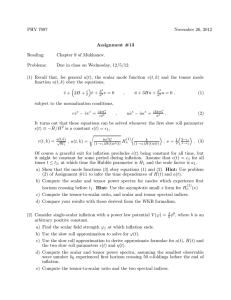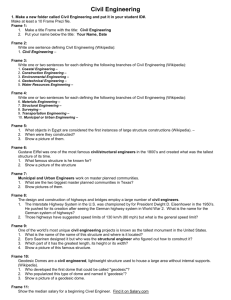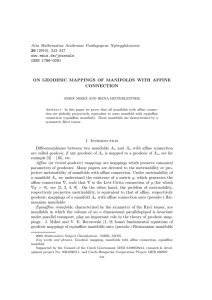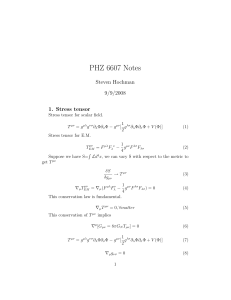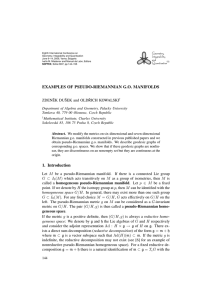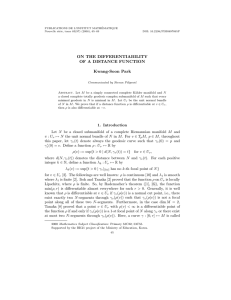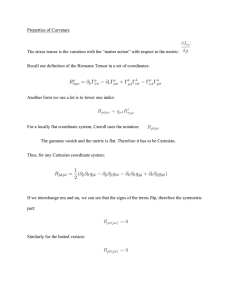Acta Mathematica Academiae Paedagogicae Ny´ıregyh´ aziensis (2010), 221–230 26
advertisement
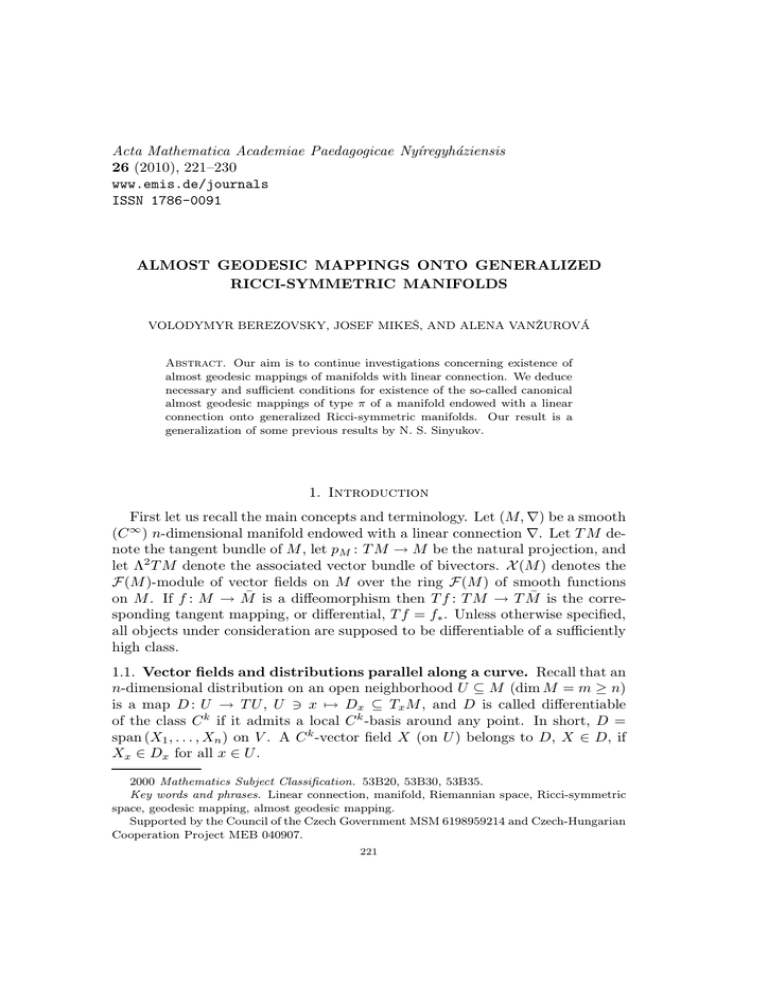
Acta Mathematica Academiae Paedagogicae Nyı́regyháziensis
26 (2010), 221–230
www.emis.de/journals
ISSN 1786-0091
ALMOST GEODESIC MAPPINGS ONTO GENERALIZED
RICCI-SYMMETRIC MANIFOLDS
VOLODYMYR BEREZOVSKY, JOSEF MIKEŠ, AND ALENA VANŽUROVÁ
Abstract. Our aim is to continue investigations concerning existence of
almost geodesic mappings of manifolds with linear connection. We deduce
necessary and sufficient conditions for existence of the so-called canonical
almost geodesic mappings of type π of a manifold endowed with a linear
connection onto generalized Ricci-symmetric manifolds. Our result is a
generalization of some previous results by N. S. Sinyukov.
1. Introduction
First let us recall the main concepts and terminology. Let (M, ∇) be a smooth
(C ∞ ) n-dimensional manifold endowed with a linear connection ∇. Let T M denote the tangent bundle of M , let pM : T M → M be the natural projection, and
let Λ2 T M denote the associated vector bundle of bivectors. X (M ) denotes the
F (M )-module of vector fields on M over the ring F (M ) of smooth functions
on M . If f : M → M̄ is a diffeomorphism then T f : T M → T M̄ is the corresponding tangent mapping, or differential, T f = f∗ . Unless otherwise specified,
all objects under consideration are supposed to be differentiable of a sufficiently
high class.
1.1. Vector fields and distributions parallel along a curve. Recall that an
n-dimensional distribution on an open neighborhood U ⊆ M (dim M = m ≥ n)
is a map D : U → T U , U ∋ x 7→ Dx ⊆ Tx M , and D is called differentiable
of the class C k if it admits a local C k -basis around any point. In short, D =
span (X1 , . . . , Xn ) on V . A C k -vector field X (on U ) belongs to D, X ∈ D, if
Xx ∈ Dx for all x ∈ U .
2000 Mathematics Subject Classification. 53B20, 53B30, 53B35.
Key words and phrases. Linear connection, manifold, Riemannian space, Ricci-symmetric
space, geodesic mapping, almost geodesic mapping.
Supported by the Council of the Czech Government MSM 6198959214 and Czech-Hungarian
Cooperation Project MEB 040907.
221
222
VOLODYMYR BEREZOVSKY, JOSEF MIKEŠ, AND ALENA VANŽUROVÁ
Let c : I → M , t 7→ c(t), with I ⊂ R being an open interval, denote a (C k -,
k−1
or smooth) curve on M . Let ξ denote the corresponding
(C
, or smooth)
dc(t)
tangent (“velocity”) vector field along c, ξ(t) = c(t), dt , t ∈ I. In the
following, we will consider only those curves which are regular in the sense that
the tangent vector field ξ along c does not vanish on the definition domain I,
that is, c′ (t) = dc(t)
dt 6= 0 for all t ∈ I. Besides the velocity field ξ, let us introduce
vector fields ξ1 , ξ2 , associated to a curve c, by the formula
(1)
ξ1 = ∇ξ ξ,
ξ2 = ∇ξ ξ1
Under a (C k -)vector field along c we mean a (C k -)mapping Y : I → T M such
that pM ◦ Y = c, that is, Y (t) ∈ Tc(t) M for any t ∈ I. Similarly, a differentiable
n-distribution along c can be introduced as a span of an n-tuple of (differentiable) vector fields along c. The velocity field ξ(t) generates a one-dimensional
distribution Ξ along c. Remark that any differentiable vector field (differentiable
distribution, respectively) along c can be extended into a differentiable vector
field (distribution) on some neighborhood U of c(I).
Denote by τc(t0 ),c(t) the parallel transport along c relative to ∇ from c(t0 ) to
c(t). A vector field Y along c on (M, ∇) is called parallel along c relative to the
given connection if ∇ξ Y = 0. A distribution D (defined along c, or on some
open neighborhood of c(I)) is called parallel along c if for any t0 ∈ I and any
vector X0 ∈ Dc(t0 ) , the image of X0 under the parallel translation τ along c
(from the point c(t0 ) to c(t)) belongs to D, τc(t0 ),c(t) X0 ∈ Dc(t) for all t ∈ I. A
distribution D parallel along c admits a (local) basis parallel along c; parallelism
along c is independent on reparametrizations of the path.
Lemma 1. Let D be a two-dimensional distribution along c. Let X1 , X2 be
vector fields along c which form a basis of D; D = span (X1 , X2 ). Then the
necessary and sufficient condition for D to be parallel along c may be expressed
as follows: there are real function aji : I → R of the parameter t such that
(2)
∇ξ Xi = aji Xj ,
i, j ∈ {1, 2}
hold (covariant derivatives along c of basis vector fields belong to the distribution, [5, p. 4].
1.2. Almost geodesic curves. Let (M, ∇) be a smooth manifold endowed with
a linear connection. Let c : I → M be a smooth regular curve on M . Recall that
c is called a geodesic curve (in short, g.c.), under a general parametrization, if for
any initial value t0 ∈ I of the parameter, the vector field τc(t0 ),c(t) (ξ(t0 )) along
c arising from images of ξ(t0 ) under the parallel propagation along c, belongs to
the 1-dimensional distribution Ξ = span (ξ) along c (generated by the velocity
field). Hence the vectors ξ1 (t) and ξ(t) are collinear for any t ∈ I if and only if
c is a geodesic curve. Equivalently, c is a g. c. if and only if ξ is recurrent along
ALMOST GEODESIC MAPPINGS. . .
223
c which means: there is a real function λ(t) : I → R such that the formula
(3)
∇ξ(t) ξ(t) = λ(t)ξ(t)
holds. If the curve is parametrized by canonical (affine) parameter, the condition
(3) for geodesic curves take the usual form ∇ξ(s) ξ(s) = 0 for ∈ I, and we speak
about geodesics.
Geodesic curves can be naturally generalized as follows. According to [5], we
call c almost geodesic if there is a 2-dimensional (differentiable) distribution D
(along c, or on some neighborhood of c(I)) parallel along c relative to ∇ such that
the tangent vector field ξ belongs to D (or Ξ is a subdistribution of D), ξ(t) ∈
Dc(t) for t ∈ I. Equivalently, c is almost geodesic if and only if there exist vector
fields X1 , X2 along c satisfying (2), i.e. parallel, and (differentiable) real functions
bi (t), t ∈ R, defined along c, such that ξ = b1 X1 + b2 X2 holds. Obviously,
geodesic curves, particularly geodesics, can serve as examples of almost geodesic
curves.
For almost geodesic curves, ξ1 and ξ2 from (1) belong to the corresponding
distribution D. If the vector fields ξ and ξ1 are independent at any point (the
(local) curve c is not a geodesic one), then D = span (ξ, ξ1 ). So we can easily
check that another equivalent characterization is:
Lemma 2. A curve is almost geodesic if and only if ξ2 ∈ span (ξ, ξ1 ).
2. Almost geodesic mappings
The concept of an almost geodesic mapping was introduced by V. M. Chernyshenko [3], and later on by N. S. Sinyukov, from a rather different point of
view, [5, 6, 7, 8]. The theory of almost geodesic mappings in a developed form
can be found in [5, 6, 7, 8].
¯ be smooth n-dimensional manifolds, n > 2, endowed with
Let (M, ∇), (M̄ , ∇)
torsion-free linear connection.
Definition. [5, 6, 7, 8] A diffeomorphism f : M → M̄ is called almost geodesic
if any geodesic curve of (M, ∇) is mapped under f onto an almost geodesic curve
¯
in (M̄ , ∇).
Conventions. From now on, all connections under consideration are torsionfree (≡ symmetric). If f : M → M̄ is a diffeomorphism we always suppose that
¯ are defined on the same manifold M , and we may
the connections ∇ and ∇
¯ which is more convenient
in fact assume diffeomorphisms f : (M, ∇) → (M, ∇),
from the technical reasons: we can make use of the well-known fact that two
¯ on the same manifold M always differ up to a
linear connections ∇ and ∇
(1, 2)-tensor field P ,
¯
(4)
∇(X,
Y ) = ∇(X, Y ) + P (X, Y ),
X, Y ∈ X (M ),
and if the connections are symmetric, then P is also symmetric in X, Y . Moreover, we always identify a given curve c with its image c̄ = f ◦ c, similarly we
224
VOLODYMYR BEREZOVSKY, JOSEF MIKEŠ, AND ALENA VANŽUROVÁ
identify the tangent vector function ξ(t) with the corresponding vector function
¯ then P deterξ̄(t) = T f (ξ(t)). Given a diffeomorphism f : (M, ∇) → (M, ∇)
mined by (4) will be called here the deformation tensor of the given connections
under f ([6]). For a deformation tensor P (of type (1, 2)), let us introduce a new
tensor field (of type (1, 3), denoted by the same symbol) by
X
P (X, Y, Z) =
∇Z P (X, Y ) + P (P (X, Y ), Z), X, Y, Z ∈ X (M )
CS(X,Y,Z)
P
where CS( , , ) means the cyclic sum on arguments in brackets (i. e. symmetrization without coefficients). Let X ∧Y means a decomposable bivector, an exterior
¯ is almost-geodesic
product of X and Y . A diffeomorphism f : (M, ∇) → (M, ∇)
if and only if the deformation tensor P satisfies
(5)
P (X1 , X2 , X3 ) ∧ P (X4 , X5 ) ∧ X6 = 0 for all Xi ∈ X (M ), i = 1, . . . , 6.
[h
j]
i
In local coordinates, (5) reads P(pqr Psu
δv) = 0 where the round and square
brackets denote symmetrization and alternation of indices, respectively.
3. Classification of almost geodesic mappings
N.S. Sinyukov distinguished three kinds of almost geodesic mappings, [5, 6],
namely π1 , π2 , and π3 , characterized, respectively, by the conditions for the
deformation tensor:
π1 : P (X, X, X) + P (P (X, X), X) = a(X, X)·X + b(X)·P (X, X), X ∈ X (M ),
where a is a symmetric type (0, 2) tensor field and b is a one-form;
π2 : P (X, X) = ψ(X) · X + ϕ(X) · F (X),
X ∈ X (M ),
where ψ and φ are one-forms, and F is a type (1, 1) tensor field satisfying
(∇F )(X; X) + F (F (X), X) = µ(X) · X + ̺(X) · F (X),
X ∈ X (M )
for some one-forms µ, ̺;
π3 : P (X, X) = ψ(X) · X + a(X, X) · Z,
X ∈ X (M )
where ψ is a one-form, a is a symmetric bilinear form and Z ∈ X (M ) is a vector
field satisfying
(∇Z)(X) = h · X + θ(X) · Z
for some scalar function h : M → R and some one-form θ.
The so-called π̃1 -mappings, canonical almost geodesic mappings, are characterized among almost geodesic mappings by the condition b = 0 on the right
hand side. That is, the deformation tensor of a π̃1 -mapping satisfies
(6)
P (X, X, X) + P (P (X, X), X) = a(X, X) · X,
X ∈ X (M ).
It is known that any π1 -mapping arises as a composition of a π̃1 -mapping and
a geodesic one. But geodesic mappings can be considered as trivial almost
ALMOST GEODESIC MAPPINGS. . .
225
geodesic mappings, and can be omitted in our further considerations; they have
been analysed and classified in [1]. Our aim is to study π̃1 -mappings of affine
manifolds onto particular types of Riemannian spaces, namely those cases that
induce integrable systems.
4. Ricci-symmetric and generalized Ricci-symmetric manifolds
Under a Ricci-symmetric manifold (space) we mean a manifold (M, ∇) with
linear connection (a pseudo-Riemannian space (M, g), respectively) for which
the Ricci tensor is parallel (=covariantly constant),
∇Ric = 0.
It was proven in [6] that the family of all π̃1 -mappings of a manifold (M, ∇)
(= “affine manifold”) onto Ricci-symmetric (pseudo-)Riemannian spaces (M̄ , ḡ)
¯ Ric
¯ = 0) is given by an integrable system of differentiable equations (in covari(∇
ant derivatives). Consequently, given a manifold with a symmetric connection,
the family of all Ricci-symmetric Riemannian spaces (M̄ , ḡ) which can serve as
images of the given manifold (M, ∇) under some π̃1 -mapping, depends on a finite
set of parameters.
On the other hand, geodesic mappings form a subset in the set of π̃1 -mappings;
they obey the definition. But basic equations describing geodesic mappings of a
manifold with linear connection do not form an integrable system of Cauchy type,
since a general solution depends on n arbitrary functions. It follows that the
conditions (6) describing π̃1 -mappings (i.e. canonical almost geodesic mappings)
of affine manifolds do not, in general, induce an integrable system.
In the following, we consider a particular case when (6) can be transformed
into an integrable system, generalizing the results of Sinyukov. Namely, we
will investigate π̃1 -mappings of an affine manifold (M, ∇) onto the so-called
generalized Ricci-symmetric manifolds.
An affine manifold (M, ∇) will be called a generalized Ricci-symmetric manifold if its Ricci tensor satisfies
(7)
∇Ric (Y, Z; X) + ∇Ric (X, Z; Y ) = 0,
that is, ∇X Ric (Y, Z) = −∇Y Ric (X, Z). We do not a priori suppose the Ricci
tensor be symmetric. If Ric is symmetric and (7) holds then Ric is parallel,
∇Ric = 0, and (M, ∇) is a Ricci-symmetric manifold. Einstein spaces (Riemannian spaces characterized by the property that the Ricci tensor is proportional to the metric tensor) satisfy (7) since they satisfy ∇Ric = 0, hence are
generalized Ricci-symmetric. In this sense, generalized Ricci-symmetric spaces
can be considered as a certain generalization of Einstein spaces.
226
VOLODYMYR BEREZOVSKY, JOSEF MIKEŠ, AND ALENA VANŽUROVÁ
5. Almost geodesic mappings π̃1 onto generalized Ricci-symmetric
manifolds
¯ with the
Given affine m-dimensional manifolds A = (M, ∇) and Ā = (M̄ , ∇)
corresponding curvature tensors R and R̄, respectively, all connection-preserving
mappings f : M → M̄ can be described by the following system of (differential)
equations, [6, 7, 8]:
3(∇Z P (X, Y ) + P (Z, P (X, Y )))
X
=
(R(Y, Z)X − R̄(Y, Z)X) +
CS(X,Y )
X
a(X, Y )Z.
CS(X,Y,Z)
It becomes clear that the above invariant formulas are rather complicated. As
for the rest, we prefer to express our equalities in local coordinates (with respect
to a map (U, ϕ) on M ). This formulas have the following local expression
(8)
h
h
h
h
3(Pij,k
+ Pkα
Pijα ) = R(ij)k
− R̄h(ij)k + a(ij δk)
,
h
where Pijh , aij , Rijk
, R̄hijk are local components of tensors P , R, R̄ and a,
respectively, δkh is the Kronecker delta, “,” denotes covariant derivative with
respect to ∇.
The system (8) can be considered as a system of partial differential equations for functions Pijh on M , i.e. for components of the deformation tensor; the
corresponding integrability conditions are
h
h
h
h
h
h
α
R̄(ij)[k,ℓ]
= R(ij)[k,ℓ]
+ δ(i
ajk),ℓ − δ(i
ajℓ),k − 3(−Pijα R̄αkℓ
+ Pα(j
Ri)kℓ
)
α
α
α
h
α
α
α
h
ajk) ).
δ(i
− R̄(ij)k
(R(ij)k
ajℓ) ) + Pαℓ
δ(i
− R̄(ij)ℓ
(R(ij)ℓ
− Pαk
¯ R̄ on the left hand side we get the following integrability
Passing from ∇R̄ to ∇
conditions of the system (8):
(9)
h
h
h
= δ(i
ajk),ℓ − δ(i
ajℓ),k + Θhijkℓ ,
R̄(ij)[k;ℓ]
where
h
h
α
h
)
+ Pα(j
Ri)kℓ
− 3(−Pijα R̄αkℓ
Θhijkℓ = R(ij)[k,ℓ]
α
h
α
α
α
h
α
α
ajk) )
δ(i
ajℓ) ) + Pαℓ
(R(ij)k
− R̄(ij)k
δ(i
− Pαk
(R(ij)ℓ
− R̄(ij)ℓ
α
h
α
h
α
h
α
h
− Pℓ(i
R̄|α|j)k
− Pℓ(i
R̄j)αk
+ Pk(i
R̄|α|j)ℓ
+ Pk(i
R̄j)αℓ
.
Using the Bianchi identity we can write (9) in local coordinate as
h
h
h
h
= δ(i
ajk),ℓ − δ(i
ajℓ),k + Θhijkℓ ,
+ R̄jℓk;i
R̄iℓk;j
¯ Contraction in h and
where “;” denotes covariant derivative with respect to ∇.
k gives the following equality for covariant derivatives of components of the Ricci
¯ of ∇:
¯
tensor Ric
(10)
R̄iℓ;j + R̄jℓ;i = (n + 1)aij,ℓ − aℓ(i,j) + Θα
ijαℓ .
ALMOST GEODESIC MAPPINGS. . .
227
¯ is a generalized
In the following let us suppose that the affine manifold (M̄ , ∇)
Ricci-symmetric space, that is, (7) holds. In local coordinates, (7) reads
R̄ij;k + R̄kj;i = 0.
Under this assumption, (10) reads
(n + 1)aij,ℓ − aℓi,j − aℓj,i = −Θα
ijαℓ .
(11)
Using symmetrization in ℓ, i gives
1
2
aℓi,j + aℓj,i = − Θα
aij,ℓ .
(i|ℓα|j) +
n
n
Now (11) reads
1 α
n2 + n − 2
aij,ℓ = − Θα
Θ
.
ijαℓ −
n
n (i|ℓα|j)
¯ to the integrability condiApplying covariant differentiation with respect to ∇
¯ to ∇ on the right hand
tions (9), followed by passing from covariant derivative ∇
side, we get
(12)
h
h
h
h
h
R̄(ij)k;ℓm
− R̄(ij)ℓ;mk
= δ(i
ajk),ℓm − δ(i
ajℓ),km + Tijkℓm
,
(13)
where
h
h
α
α
h
α
h
α
h
Tijkℓm
= R̄αmk
R̄(ij)ℓ
− R̄ℓmk
R̄(ij)α
− R̄jmk
R̄(iα)ℓ
− R̄imk
R̄(jα)ℓ
α h
α h
α h
h
α
α h
δ(i ajk),α
δ(α ajk),ℓ − Pmk
δ(α aij),ℓ − Pml
− Pmα
δ(i
ajk),ℓ − Pmj
δ(i aαk),ℓ − Pmi
h
α
α h
α h
α h
α h
− Pmα
δ(i
ajℓ),k + Pmi
δ(α ajℓ),k + Pmj
δ(i aαℓ),k + Pmk
δ(i ajℓ),α − Pml
δ(i ajα),k
h
h
α
α h
α h
α h
α h
− θijkℓ,m
+ Pαm
θijkℓ
− Pmi
θαjkℓ − Pmj
θiαkℓ − Pmk
θijαℓ − Pmℓ
θijkα .
Alternating (13) in ℓ, m we obtain
h
h
h
R̄h(ij)m;ℓk − R̄h(ij)ℓ;mk = δ(i
ajm),kℓ − δ(i
ajℓ),km + Tijk[lm]
(14)
h
α
α
h
h
α
+ R̄h(i|αk| R̄α
j)mℓ + R̄(ij)α R̄kmℓ − R̄(ij)k R̄αmℓ + R̄α(i|k| R̄j)mℓ
h
α
h
α
h
α
h
α
+ δ(α
ajk) Riℓm
+ δ(α
aik) Rjℓm
+ δ(i
ajα) Rkℓm
− δ(i
ajk) Rαℓm
.
Due to the properties of the Riemannian tensor, (14) can be written as
(15)
h
h
h
ajℓ),km − δ(i
ajm),kℓ − Nijkℓm
,
R̄himℓ;jk + R̄hjmℓ;ik = δ(i
where
h
h
h
α
h
α
h
Nijkℓm
= Tijk[ℓm]
+ R̄α
imℓ R̄(αj)k + R̄jmℓ R̄(αi)k + R̄kmℓ R̄(ij)α
h
α
h
α
h
α
h
− R̄hαmℓ R̄α
(ij)k + δ(α ajk) Riℓm + δ(α aik) Rjℓm + δ(α aij) Rkℓm − a(ij Rk)ℓm .
Let us alternate (15) in j, k. We get
(16)
h
h
h
h
ajℓ),km − δ(i
ajm),kℓ − δ(i
akℓ),jm + δ(i
akm),jℓ
R̄hjmℓ;ik − R̄hkmℓ;ij = δ(i
h
h
α
h
α
α
h
− Ni[jk]ℓm
+ R̄hαmℓ R̄α
ikj + R̄iαℓ R̄mkj + R̄imα R̄ℓkj − R̄imℓ R̄αkj .
228
VOLODYMYR BEREZOVSKY, JOSEF MIKEŠ, AND ALENA VANŽUROVÁ
Let us interchange i and k in (15), and then use (16). We evaluate
(17)
h
h
h
h
2R̄jmℓ;ik
= δ(i
ajℓ),km − δ(i
ajm),kℓ − δ(k
ajm),iℓ
h
h
h
+ δ(i
akm),jℓ − δ(i
akℓ),jm + δ(jℓ
ak),im + Ωhijkℓm ,
where
h
h
α
h
α
h
+ Nk[ij]kℓm
− R̄hαmℓ R̄α
Ωhijkℓm = −Nijkℓm
(kj)i + R̄jαℓ R̄mik + R̄jmα R̄ℓik
h
α
h
α
h
α
h
α
α
h
− R̄hαi(j R̄α
k)mℓ + R̄jαℓ R̄mik + R̄jmα R̄ℓik − R̄αmℓ R̄ikj − R̄iαℓ R̄mkj + R̄im[ℓ R̄α]kj .
On the left hand side of (17), let us pass from covariant derivative with respect
¯ to ∇:
to ∇
(18)
h
h
h
h
2R̄jmℓ,ik
= δ(i
ajℓ),km − δ(i
ajm),kℓ − δ(k
ajm),iℓ
h
h
h
h
+ δ(i
akm),jℓ − δ(i
akℓ),jm − δ(k
ajℓ),im + Sijkℓm
,
where
h
h
α
α
h
Pjk
Pℓk
− R̄αmℓ,i
= Ωhijkℓm − 2 [R̄jmℓ,i
Sijkℓm
h
α
h
α
h
α
− R̄jαℓ,i
Pmk
− R̄jmα,i
Pℓk
− R̄jmℓ,α
Pik
β
h
α
h
α
h
Piℓα )Pkh
− R̄jmα
Pim
Pαi
Pijα − R̄jαℓ
− (R̄jmℓ
− R̄αmℓ
¯ β
α
h
α
h
α
h
h
α
)Pik
Pβℓ
− R̄jmα
Pβm
− R̄jαℓ
Pβj
− R̄αmℓ
Pαβ
− (R̄jmℓ
β
α
h
h
α
h
α
h
α
− (R̄m
ℓ Pαi − R̄αmℓ Pi − R̄βαℓ Pim − R̄βmα Piℓ )Pjk
¯
¯
β
α
h
h
h
h
− (R̄jβℓ
Pαi
− R̄αβℓ
Pjiα − R̄jαℓ
Piα − R̄jβα
Piℓα )Pkm
¯ α
β
α
h
h
h
h
− (R̄jmβ
Pαi
− R̄αmβ
Pjiα − R̄jαβ
Pmi − R̄jmα
Piα )Pkℓ
].
¯
h
h
Denoting Rjmℓi
= R̄jmℓ,i
, i. e. introducing a new tensor field of type (1, 4) we
can write the system (18) in the following form
h
h
= Rjmℓi
R̄jmℓ,i
(19)
and
(20)
h
h
h
h
2Rjmℓi,k
= δ(i
ajℓ),km − δ(i
ajm),kℓ − δ(k
ajm),iℓ
h
h
h
h
+ δ(i
akm),jℓ − δ(i
akℓ),jm + δ(k
ajℓ),im + Sijkℓm
,
where we used (12).
It can be verified that the equations (8), (12), (19) and (20) for functions
h
h
Pijh (x), aij (x), R̄ijk
(x) and Rijkm
(x) on (M, ∇) form an integrable system; the
above functions must satisfy also additional algebraic conditions
(21)
Pijh (x) = Pjih (x),
aij (x) = aji (x),
h
h
R̄i(jk)
(x) = R̄(ijk)
(x) = 0,
h
h
Ri(jk)ℓ
(x) = R(ijk)ℓ
(x) = 0.
ALMOST GEODESIC MAPPINGS. . .
229
So we have succeeded to prove the following generalization of the result of
Sinyukov [7, 8] (we use the above notation).
¯ a genTheorem. Let (M, ∇) be a manifold with affine connection and (M̄ , ∇)
eralized Ricci-symmetric manifold. There is a π̃1 mapping f : M → M̄ (i.e. a
canonical almost geodesic mapping of type π1 ) if and only if there exist funch
h
tions Pijh (x), aij (x), R̄ijk
(x) and Rijkm
(x) which satisfy the equations (8), (12),
(19), (20), and (21). The system of equations (8), (12), (19) and (20) forms a
Cauchy type system of PDE’s in covariant derivatives.
As a consequence we obtain
Corollary. The family of all generalized Ricci-symmetric manifolds, which can
serve as an image of the given affine manifold (M, ∇) under some π̃1 -mapping,
depends on at most
(22)
1
n(n + 1)(2n3 − 4n2 + 5n + 3)
6
parameters.
References
[1] V. Berezovski and J. Mikeš. On a classification of almost geodesic mappings of affine
connection spaces. Acta Univ. Palack. Olomuc. Fac. Rerum Natur. Math., 35:21–24 (1997),
1996.
[2] V. E. Berezovski, J. Mikeš, and A. Vanžurová. Canonical almost geodesic mappings of
type π̃1 onto pseudo-Riemannian manifolds. In Differential geometry and its applications,
pages 65–75. World Sci. Publ., Hackensack, NJ, 2008.
[3] V. M. Chernyshenko. Affine-connected spaces with a correspondent complex of geodesics.
Collection of Works of Mech.-Math. Chair of Dnepropetrovsk Univ., 6:105–118, 1961.
[4] J. Mikeš, V. Kiosak, and A. Vanžurová. Geodesic mappings of manifolds with affine connection. Palacký University Olomouc, Olomouc, 2008.
[5] N. S. Sinyukov. Almost geodesic mappings of affinely connected and Riemannian spaces.
Dokl. Akad. Nauk SSSR, 151:781–782, 1963.
[6] N. S. Sinyukov. Geodezicheskie otobrazheniya rimanovykh prostranstv. “Nauka”, Moscow,
1979.
[7] N. S. Sinyukov. Almost geodesic mappings of affine connected and Riemannian spaces.
Itogi Nauki Tekh., Ser. Probl. Geom., 13:3–26, 1982.
[8] N. S. Sinyukov. Almost-geodesic mappings of affinely connected and Riemann spaces. J.
Sov. Math., 25:1235–1249, 1984.
230
VOLODYMYR BEREZOVSKY, JOSEF MIKEŠ, AND ALENA VANŽUROVÁ
Department of Mathematics,
University of Uman,
Institutskaya 1, Uman
Ukraine
E-mail address: berez.volod@rambler.ru
Department of Algebra and Geometry,
Faculty of Science,
Palacky University of Olomouc,
17. Listopadu 12, 77200 Olomouc,
Czech Republic
E-mail address: mikes@inf.upol.cz
Department of Algebra and Geometry,
Faculty of Science,
Palacky University of Olomouc,
17. Listopadu 12, 77200 Olomouc,
Czech Republic
E-mail address: vanzurov@inf.upol.cz

